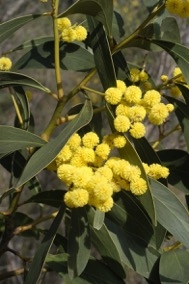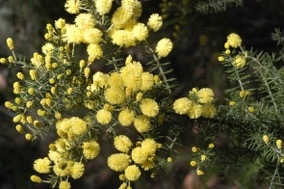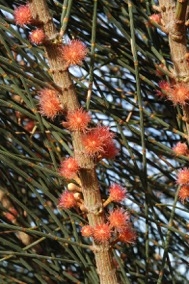We are now in mid-winter, cold, wet and with grey skies, but the bushland has many and varied surprises for you when you go for a leisurely walk.
The acacias keep on giving with their range of golden flowers.
Golden Wattle, Acacia pycnantha, is Australia’s floral emblem. It is an erect or spreading small tree widespread from dry to damp valley and plains grasslands. It has dark green, broad, leathery phyllodes with a prominent midrib. The flowers are globular and are made up of a cluster of tiny individual flowers. The conspicuous stamens give the head its fluffy appearance. Acacia flowers produce copious pollen, but do not produce nectar. With its outstanding colour, this plant demands attention!

Golden Wattle
Prickly Moses, Acacia verticillata, prefers a damp or valley habitat. It grows to about 3m, is an open shrub and has fine prickly phyllodes that are rigid in whorls along the stem. There is a ground cover subspecies of this plant. It is useful as a bird refuge, and Aborigines used the fibre to make fishing lines.

Prickly Moses
Drooping Sheoak, Allocasuarina verticillata, is a large shrub or tree to 10m, common and widespread in coastal areas. It is erect with a dense rounded crown of drooping greyish-green branchlets and its leaves are reduced to rings of scales. At this time the male tree displays masses of tiny russet-tan flowers (catkins) at the end of the branchlets, which are an attractive feature.

Male Drooping Sheoak
The female sheoak bears globular reddish-orange flowers which, if pollinated, will develop into large barrel-shaped cones 50mm long, with valves opening to release winged nutlets or samara.

Female Drooping Sheoak
The sheoaks make excellent screening and windbreak plants.
Pink-bells or Black-eyed Susan, Tetratheca ciliata, a slender heath-like plant, grows in a variety of habitats. It has oval leaves to 12mm long, arranged in whorls of three or four, fringed with hairs. The mauve-pink or magenta flowers hang from short hairy stalks.

Pink Bells
The petals spread out as the flower ages. The dark anthers at the centre of the flower make a contrast to the delicate tone of the petals, hence the name. The fruit is a flattened capsule that splits when ready to release seeds. The plant makes an attractive container plant, but needs regular summer watering.
When out and about take time to look down at the leaf litter. There you will find wonderful coloured and textured surprises such as brilliant light green mosses and bright red, orange and rich brown fungi. Look too at the bark of the trees that you come across. Note the subtle colours and patterned and textured surfaces. Each is unique to that species. Enjoy your rambles and take a small hand-lens to reveal even more secrets. Remember to take your Flowers of Anglesea and Aireys Inlet too.
References:
Margaret MacDonald, 2009, Flowers of Anglesea and Aireys Inlet
Enid Mayfield, 2013, Flora of the Otway Plains and Ranges 2
Marilyn Bull, 2014 Flora of Melbourne, Ed.3
Philippa Hesterman
Photos: Courtesy of Margaret MacDonald